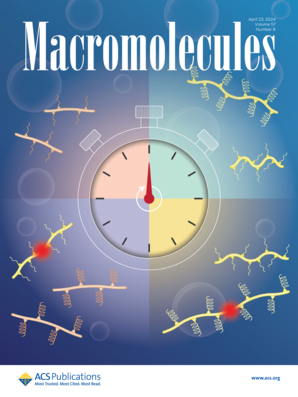Universal Viscoelastic Response of Body-Centered-Cubic Block Copolymer Solutions: Time–Temperature–Concentration Superposition
IF 5.1
1区 化学
Q1 POLYMER SCIENCE
引用次数: 0
Abstract
The microstructure and dynamic mechanical behavior of ordered block copolymer solutions are critical for tailoring the properties for various applications. While the microstructural evolution of block copolymers with polymer concentration is well understood, its correlation with rheological behavior remains insufficiently explored. In this study, we uncovered a universal relationship between the linear viscoelastic behavior and concentration of cubic ordered block copolymer solutions using a time–temperature–concentration superposition (tTcS) principle. Specifically, a polystyrene-block-poly(ethylene-alt-propylene) (SEP) copolymer (Mn = 75.2 kDa, Đ = 1.05, and fPS = 0.18) dissolved in squalane was employed as a model system. The asymmetric SEP self-assembled into a body-centered cubic (BCC) structure across all concentrations, from 10% to the bulk. Increasing SEP content induced changes in both micelle and ordered lattice structures, resulting in higher aggregation numbers and reduced intermicelle distances. As the micelles became more closely packed, the enhanced entanglement of the corona chains influenced the rheological properties, establishing a direct correlation with the microstructural changes. The concentration-dependent horizontal shift factor (ac) in the block copolymer solutions exhibited a stronger dependence on the degree of entanglement of corona chains compared to typical homopolymer solutions. This behavior arises from the terminally anchored PEP chains, which follows an exponential relationship with the degree of entanglement as in star polymers. In contrast, the vertical shift factor (bc) reflected lattice elasticity dictated by the density of corona chains, which is directly determined by the intermicelle distance and aggregation number.

体心立方嵌段共聚物溶液的通用粘弹性响应:时间-温度-浓度叠加
有序嵌段共聚物溶液的微观结构和动态力学行为对于定制各种应用的性能至关重要。虽然嵌段共聚物的微观结构随聚合物浓度的变化已经被很好地理解,但其与流变行为的关系仍然没有得到充分的探讨。在这项研究中,我们利用时间-温度-浓度叠加(tTcS)原理揭示了线性粘弹性行为与立方有序嵌段共聚物溶液浓度之间的普遍关系。具体来说,以一种溶解于角鲨烷中的聚苯乙烯-嵌段聚(乙烯-丙烯-丙烯)(SEP)共聚物(Mn = 75.2 kDa, Đ = 1.05, fPS = 0.18)为模型体系。不对称SEP自组装成体心立方(BCC)结构,在所有浓度下,从10%到散装。SEP含量的增加引起胶束和有序晶格结构的变化,导致胶束聚集数的增加和胶束间距的减小。当胶束变得更紧密时,电晕链的纠缠增强影响了流变性能,建立了与微观结构变化的直接关系。与典型的均聚物溶液相比,嵌段共聚物溶液中的浓度依赖水平位移因子(ac)对电晕链缠结程度的依赖性更强。这种行为源于末端锚定的PEP链,与星形聚合物的纠缠度呈指数关系。垂直位移因子(bc)反映了晶格弹性,这取决于电晕链的密度,而电晕链的密度直接取决于胶束间距和聚集数。
本文章由计算机程序翻译,如有差异,请以英文原文为准。
求助全文
约1分钟内获得全文
求助全文
来源期刊

Macromolecules
工程技术-高分子科学
CiteScore
9.30
自引率
16.40%
发文量
942
审稿时长
2 months
期刊介绍:
Macromolecules publishes original, fundamental, and impactful research on all aspects of polymer science. Topics of interest include synthesis (e.g., controlled polymerizations, polymerization catalysis, post polymerization modification, new monomer structures and polymer architectures, and polymerization mechanisms/kinetics analysis); phase behavior, thermodynamics, dynamic, and ordering/disordering phenomena (e.g., self-assembly, gelation, crystallization, solution/melt/solid-state characteristics); structure and properties (e.g., mechanical and rheological properties, surface/interfacial characteristics, electronic and transport properties); new state of the art characterization (e.g., spectroscopy, scattering, microscopy, rheology), simulation (e.g., Monte Carlo, molecular dynamics, multi-scale/coarse-grained modeling), and theoretical methods. Renewable/sustainable polymers, polymer networks, responsive polymers, electro-, magneto- and opto-active macromolecules, inorganic polymers, charge-transporting polymers (ion-containing, semiconducting, and conducting), nanostructured polymers, and polymer composites are also of interest. Typical papers published in Macromolecules showcase important and innovative concepts, experimental methods/observations, and theoretical/computational approaches that demonstrate a fundamental advance in the understanding of polymers.
 求助内容:
求助内容: 应助结果提醒方式:
应助结果提醒方式:


